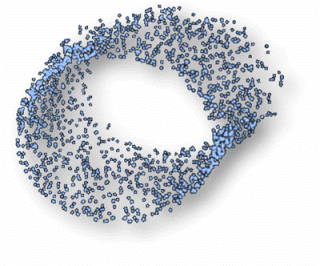
As I wrote in the introduction to the particle series, I've got only a simple particle renderer. It uses position and color data with one attached texture. In this article, you will find the renderer description and what problems we have with our current implementation.
The Series
Introduction
The gist is located here: fenbf / ParticleRenderer
The renderer's role is, of course, to create pixels from our data. I tried to separate rendering from animation and thus I have IParticleRenderer interface. It takes data from ParticleSystem and uses it on the GPU side. Currently I have only GLParticleRenderer.

A renderer does not need all of the particle system data. This implementation uses only color and position.
The "renderer - animation" separation gives a lot of flexibility. For instance, for performance tests, I've created an EmptyRenderer and used the whole system as it is - without changing even one line of code! Of course I got no pixels on the screen, but I was able to collect elapsed time data. Same idea can be applied for Unit Testing.
The Renderer Interface
class IParticleRenderer
{
public:
IParticleRenderer() { }
virtual ~IParticleRenderer() { }
virtual void generate(ParticleSystem *sys, bool useQuads) = 0;
virtual void destroy() = 0;
virtual void update() = 0;
virtual void render() = 0;
};
useQuads are currently not used. If it is set to true, then it means to generate quads - not points. This would increase amount of memory sent to the GPU.
How to Render Particles using OpenGL
Shaders
#version 330
uniform mat4x4 matModelview;
uniform mat4x4 matProjection;
layout(location = 0) in vec4 vVertex;
layout(location = 1) in vec4 vColor;
out vec4 outColor;
void main()
{
vec4 eyePos = matModelview * gl_Vertex;
gl_Position = matProjection * eyePos;
outColor = vColor;
float dist = length(eyePos.xyz);
float att = inversesqrt(0.1f*dist);
gl_PointSize = 2.0f * att;
}
The above vertex shader uses color and position. It computes gl_Position and gl_PointSize.
Fragment shaders is quite trivial, so I will not paste code here. :)
OpenGL Particle Renderer Implementation
Update()
void GLParticleRenderer::update()
{
const size_t count = m_system->numAliveParticles();
if (count > 0)
{
glBindBuffer(GL_ARRAY_BUFFER, m_bufPos);
float *ptr = (float *)(m_system->finalData()->m_pos.get());
glBufferSubData(GL_ARRAY_BUFFER, 0, count*sizeof(float)* 4, ptr);
glBindBuffer(GL_ARRAY_BUFFER, m_bufCol);
ptr = (float*)(m_system->finalData()->m_col.get());
glBufferSubData(GL_ARRAY_BUFFER, 0, count*sizeof(float)* 4, ptr);
glBindBuffer(GL_ARRAY_BUFFER, 0);
}
}
As you can see, update() takes needed data and update renderer's buffers.
Render()
void GLParticleRenderer::render()
{
const size_t count = m_system->numAliveParticles();
if (count > 0)
{
glBindVertexArray(m_vao);
glDrawArrays(GL_POINTS, 0, count);
glBindVertexArray(0);
}
}
plus the whole context:
glEnable(GL_TEXTURE_2D);
glBindTexture(GL_TEXTURE_2D, gParticleTexture);
glEnable(GL_PROGRAM_POINT_SIZE);
mProgram.use();
mProgram.uniformMatrix4f("matProjection", camera.projectionMatrix);
mProgram.uniformMatrix4f("matModelview", camera.modelviewMatrix);
glEnable(GL_BLEND);
glBlendFunc(GL_SRC_ALPHA, GL_ONE);
gpuRender.begin();
gCurrentEffect->render(); gpuRender.end();
glDisable(GL_BLEND);
mProgram.disable();
The Problems
 The OpenGL renderer is simple and it works. But unfortunately, it is not the ideal and production ready code! Here is a list of things to improve:
The OpenGL renderer is simple and it works. But unfortunately, it is not the ideal and production ready code! Here is a list of things to improve:
- buffer updates: Just a simplest method right now. It could be improved by using mapping and double buffering.
- texture ID in the renderer - As a member, not outside! Additionally, we could think about using texture atlas and a new parameter for a particle -
textID. That way, each particle could use different texture. - only point rendering. There is this variable
useQuads, but maybe it would be better to use geometry shader to generate quads.
- quads would allow us to easily rotate particles.
- Lots of great ideas about particle rendering can be found under this stackoverflow question: Point Sprites for particle system
CPU to GPU
Actually, the main problem in the system is the CPU side and the memory transfer to GPU. We loose not only via data transfer, but also because of synchronization. GPU sometimes (or even often) needs to wait for previous operations to finish before it can update buffers.
It was my initial assumption and a design choice. I am aware that, even if I optimize the CPU side to the maximum level, I will not be able to beat "GPU only" particle system. We have, I believe, lots of flexibility, but some performance is lost.
What's Next
This post finishes 'implementation' part of the series. We have the animation system and the renderer, so we can say that, 'something works'. Now we can take a look at optimizations! In the next few posts (I hope I will end before end of the year :)), I will cover improvements that made this whole system running something like 50% (of the initial speed). We'll see how it ends.
Questions
What do you think about the design?
What methods could be used to improve rendering part? Some advanced modern OpenGL stuff?
CodeProject
